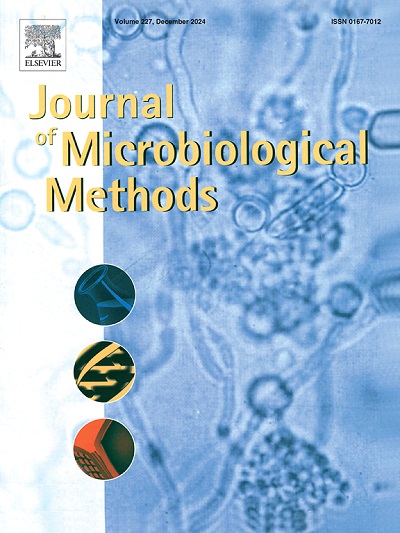通过包涵体形成和荧光监测的流线型大肠杆菌表达和纯化淀粉样肽。
IF 1.9
4区 生物学
Q4 BIOCHEMICAL RESEARCH METHODS
引用次数: 0
摘要
淀粉样蛋白肽的重组生产由于其在细菌宿主中的高聚集倾向和细胞毒性而面临重大挑战。在本研究中,我们建立了一种在大肠杆菌BL21 (DE3) pLysS中表达和纯化蛋氨酸修饰的a β40和a β42肽的简化和可重复性方法。通过利用包涵体的形成,该方案在简化纯化的同时提高了产量。该方法的一个关键特点是结合了实时荧光光谱和使用硫黄素- s和碘化丙啶的显微镜,能够对IB的形成和表达动态进行无创监测。通过pH调节、阴离子交换层析和超滤进行纯化,Aβ40的平均肽浓度为3.2 ± 1.3 mg/L, Aβ42的平均肽浓度为4.8 ± 3.2 mg/L。高效液相色谱法证实a - β40的平均纯度为90.2 % ± 0.8 %,a - β42的平均纯度为84.0 % ± 17.4 %。这些肽的结构完整性、聚集动力学和神经毒性通过PICUP、硫黄素- t荧光测定和初级海马神经元细胞毒性试验得到验证。这种无标签、经济高效的平台为生产具有生物活性的β淀粉样蛋白肽提供了可扩展的解决方案,促进了它们在结构生物学、神经退行性疾病研究和高通量药物筛选中的应用。本文章由计算机程序翻译,如有差异,请以英文原文为准。

Streamlined E. coli expression and purification of amyloid beta peptides via inclusion body formation and fluorescence monitoring
The recombinant production of amyloid beta peptides poses significant challenges due to their high aggregation propensity and cytotoxicity in bacterial hosts. In this study, we present a streamlined and reproducible method for the expression and purification of methionine-modified Aβ40 and Aβ42 peptides in Escherichia coli BL21 (DE3) pLysS. By leveraging inclusion body formation, the protocol enhances yield while simplifying purification. A key feature of this approach is the incorporation of real-time fluorescence spectroscopy and microscopy using Thioflavin-S and propidium iodide, enabling non-invasive monitoring of IB formation and expression dynamics. Purification was achieved through pH modulation, anion exchange chromatography, and ultrafiltration, yielding average peptide concentrations of 3.2 ± 1.3 mg/L for Aβ40 and 4.8 ± 3.2 mg/L for Aβ42. High-performance liquid chromatography confirmed average purities of 90.2 % ± 0.8 % for Aβ40 and 84.0 % ± 17.4 % for Aβ42. The structural integrity, aggregation kinetics, and neurotoxicity of the peptides were validated by PICUP, Thioflavin-T fluorescence assays, and cytotoxicity tests in primary hippocampal neurons. This tag-free, cost-effective platform provides a scalable solution for producing biologically active amyloid beta peptides, facilitating their use in structural biology, neurodegenerative disease research, and high-throughput drug screening.
求助全文
通过发布文献求助,成功后即可免费获取论文全文。
去求助
来源期刊

Journal of microbiological methods
生物-生化研究方法
CiteScore
4.30
自引率
4.50%
发文量
151
审稿时长
29 days
期刊介绍:
The Journal of Microbiological Methods publishes scholarly and original articles, notes and review articles. These articles must include novel and/or state-of-the-art methods, or significant improvements to existing methods. Novel and innovative applications of current methods that are validated and useful will also be published. JMM strives for scholarship, innovation and excellence. This demands scientific rigour, the best available methods and technologies, correctly replicated experiments/tests, the inclusion of proper controls, calibrations, and the correct statistical analysis. The presentation of the data must support the interpretation of the method/approach.
All aspects of microbiology are covered, except virology. These include agricultural microbiology, applied and environmental microbiology, bioassays, bioinformatics, biotechnology, biochemical microbiology, clinical microbiology, diagnostics, food monitoring and quality control microbiology, microbial genetics and genomics, geomicrobiology, microbiome methods regardless of habitat, high through-put sequencing methods and analysis, microbial pathogenesis and host responses, metabolomics, metagenomics, metaproteomics, microbial ecology and diversity, microbial physiology, microbial ultra-structure, microscopic and imaging methods, molecular microbiology, mycology, novel mathematical microbiology and modelling, parasitology, plant-microbe interactions, protein markers/profiles, proteomics, pyrosequencing, public health microbiology, radioisotopes applied to microbiology, robotics applied to microbiological methods,rumen microbiology, microbiological methods for space missions and extreme environments, sampling methods and samplers, soil and sediment microbiology, transcriptomics, veterinary microbiology, sero-diagnostics and typing/identification.
 求助内容:
求助内容: 应助结果提醒方式:
应助结果提醒方式:


